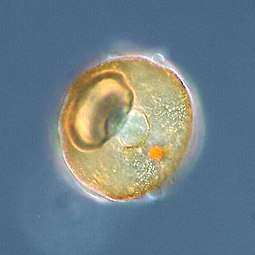Arcellinida
Arcellinid testate amoebae or Arcellinida,[1] Arcellacean[2] or lobose testate amoebae[3] are single-celled protists partially enclosed in a simple test (shell).
| Arcellinida | |
|---|---|
 | |
| Arcella sp. test | |
| Scientific classification | |
| Domain: | Eukaryota |
| (unranked): | |
| Class: | |
| Order: | Arcellinida |
Arcellinid testate amoebae are commonly found in soils, leaf litter, peat bogs and near/in fresh water.[1] They use their pseudopodia, a temporary cell extension, for moving and taking in food. Like most amoebae, they are generally believed to reproduce asexually via binary fission. However a recent review suggests that sexual recombination may be the rule rather than the exception in amoeboid protists in general, including the Arcellinid testate amoebae.[4]
Test or shell
Simple tests are made by secretion (autogenous tests), agglutination of foreign material (xenogenous tests), or sometimes a combination of both. Past environmental changes can be determined by analysing the composition of fossil tests, including the reconstruction of past climate change.[1] Testate amoebae species have been used to reconstruct hydrological changes over the late Holocene, as a result of individual species possessing a narrow tolerance for ecohydrological conditions such as water-table depth or pH.[5]
Evolutionary history
Fossils of arcellinid testate amoebae date back to the Cryogenian period.[6]
Testate amoebae are theorized to be mostly polyphyletic (coming from more than one ancestral type), but testaceafilosea, one group of testate amoebae, are theorized to be monophyletic. Ancient tests of terrestrial fauna are commonly found in fossilized amber,[7] although mid-Cretaceous testate amoeba (i.e., Diffligia, Cucurbitella) have been found in ancient lake sediments.[8] It is likely that the group has evolved minimally over the course of the Phanerozoic.
Classification
The group contains the following taxa (NB this list needs to be updated based on Adl et al. 2012),:[9][10]
- Arcellina
- Difflugiina
- Phryganellina
incertae sedis:
- Geamphorella
- Jungia
- Oopyxis
- Pseudawerintzewia
- Pseudonebela
References
- http://www.microscopy-uk.org.uk/mag/artjun03/gsamoebae.html Testate amoebae, peat bogs and past climates. accessed 16 march 2007
- Identification key for holocene lacustrine arcellacean (thecamoebian) taxa Archived December 4, 2008, at the Wayback Machine
- Lara E, Heger TJ, Ekelund F, Lamentowicz M, Mitchell EA (April 2008). "Ribosomal RNA genes challenge the monophyly of the Hyalospheniidae (Amoebozoa: Arcellinida)". Protist. 159 (2): 165–76. doi:10.1016/j.protis.2007.09.003. PMID 18023614.
- Lahr DJ, Parfrey LW, Mitchell EA, Katz LA, Lara E (2011). "The chastity of amoebae: re-evaluating evidence for sex in amoeboid organisms". Proceedings of the Royal Society B: Biological Sciences. 278 (1715): 2081–2090. doi:10.1098/rspb.2011.0289. PMC 3107637. PMID 21429931.
- Woodland, Wendy, A. (1998). "Quantitative estimates of water tables and soil moisture in Holocene peatlands from testate amoebae". The Holocene. 8 (3): 261–273. doi:10.1191/095968398667004497.
- Porter, S.A.; Knoll, A.H. (2000). "Testate amoeba in the Neoproterozoic Era: evidence from vase-shaped microfossils in the Chuar Group, Grand Canyon". Paleobiology. 26 (3): 360–385. doi:10.1666/0094-8373(2000)026<0360:taitne>2.0.co;2. Also see Cryogenian Archived October 12, 2008, at the Wayback Machine
- Schmidt, A.R.; Ragazzi, E.; Coppellotti, O.; Roghi, G. (2006). "A microworld in Triassic amber". Nature. 444 (7121): 835. doi:10.1038/444835a. PMID 17167469.
- Hengstum, Van; Reinhardt, E.G.; Medioli, F.S.; Grocke, D.R. (2007). "Exceptionally preserved late albian (Cretaceous) Arcellaceans (Thecamoebians) from the Dakota Formation near Lincoln, Nebraska" (PDF). Journal of Foraminiferal Research. 37 (4): 300–308. doi:10.2113/gsjfr.37.4.300.
- Ralf Meisterfeld: Arcellinida, In: John J. Lee, Gordon F. Leedale, Phyllis Bradbury (Hrsg.): Illustrated Guide to the Protozoa, 2nd Edition. Vol. 2, Society of Protozoologists, Lawrence, Kansas 2000, ISBN 1-891276-23-9, pp. 827-860
- Adl SM, Simpson AG, Lane CE, Lukeš J, Bass D, Bowser SS, Brown MW, Burki F, Dunthorn M, Hampl V, Heiss A, Hoppenrath M, Lara E, le Gall L, Lynn DH, McManus H, Mitchell EA, Mozley-Stanridge SE, Parfrey LW, Pawlowski J, Rueckert S, Shadwick L, Schoch CL, Smirnov A, Spiegel FW (2012). "The Revised Classification of Eukaryotes". Journal of Eukaryotic Microbiology. 59 (5): 429–514. doi:10.1111/j.1550-7408.2012.00644.x. PMC 3483872. PMID 23020233.